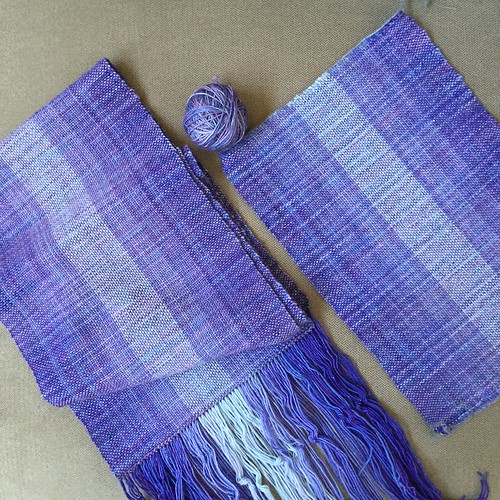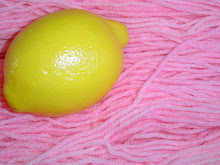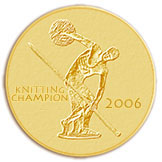Weaving
I finished up my latest weaving project yesterday. According to my notes, I warped the loom on March 20 of this past spring. Obviously, it just sat there for most of that time since I've done more than half of the project in the last two days.
The main purpose for this project was to weave a scarf with fringe. When I got to 62 inches of weaving, I measured my remaining warp and realized that even after I skipped enough for the fringe at the other end, I still had over a foot of warp that could be woven. So that's what I did. I hemstitched the second end of the scarf, skipped a section of warp for fringe, and started weaving again until I ran out of warp. Once it was off the loom, I serged the edges of the second little piece to keep it from unravelling (I did not hem stitch its edges), and now I'm ready to twist and knot the fringe on the scarf. Then I'll toss both pieces into the washer to fluff them up and after pressing them I'll trim the tails of the fringe and have a finished scarf and a small piece of handwoven fabric.
Before washing, the scarf measures 9 inches by 62 inches (without fringe) and the piece of fabric measures 9 inches by 13 inches. I have a little bit of weft yarn left, but weaving the second piece of fabric really cut down on the amount of waste from my warp, didn't take long at all, and now I have a piece of fabric to play with.
*Warp is the yarn that goes into the loom first. It runs longways with the weaving piece and must be strong enough to tolerate the weaving process. The extra warp yarn will be used as fringe for my scarf. Weft is the yarn that goes back and forth, over and under. It can be a more delicate yarn because there is less wear and tear on weft during weaving. In this project, I used two superwash, fingering weight yarns.
The main purpose for this project was to weave a scarf with fringe. When I got to 62 inches of weaving, I measured my remaining warp and realized that even after I skipped enough for the fringe at the other end, I still had over a foot of warp that could be woven. So that's what I did. I hemstitched the second end of the scarf, skipped a section of warp for fringe, and started weaving again until I ran out of warp. Once it was off the loom, I serged the edges of the second little piece to keep it from unravelling (I did not hem stitch its edges), and now I'm ready to twist and knot the fringe on the scarf. Then I'll toss both pieces into the washer to fluff them up and after pressing them I'll trim the tails of the fringe and have a finished scarf and a small piece of handwoven fabric.
Before washing, the scarf measures 9 inches by 62 inches (without fringe) and the piece of fabric measures 9 inches by 13 inches. I have a little bit of weft yarn left, but weaving the second piece of fabric really cut down on the amount of waste from my warp, didn't take long at all, and now I have a piece of fabric to play with.
*Warp is the yarn that goes into the loom first. It runs longways with the weaving piece and must be strong enough to tolerate the weaving process. The extra warp yarn will be used as fringe for my scarf. Weft is the yarn that goes back and forth, over and under. It can be a more delicate yarn because there is less wear and tear on weft during weaving. In this project, I used two superwash, fingering weight yarns.
Labels: weaving











1 Comments:
You're doing a great job weaving! Very nice selvedges and lovely color choices!
Post a Comment
<< Home